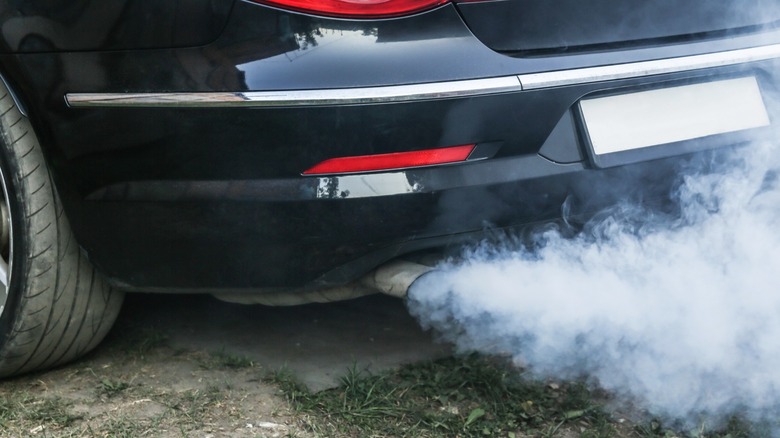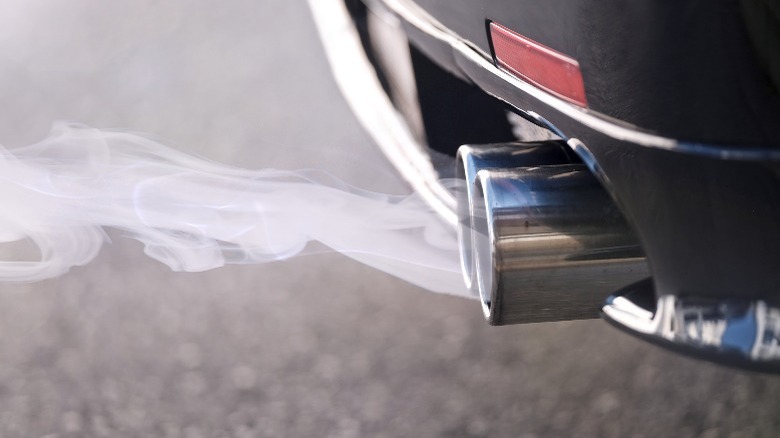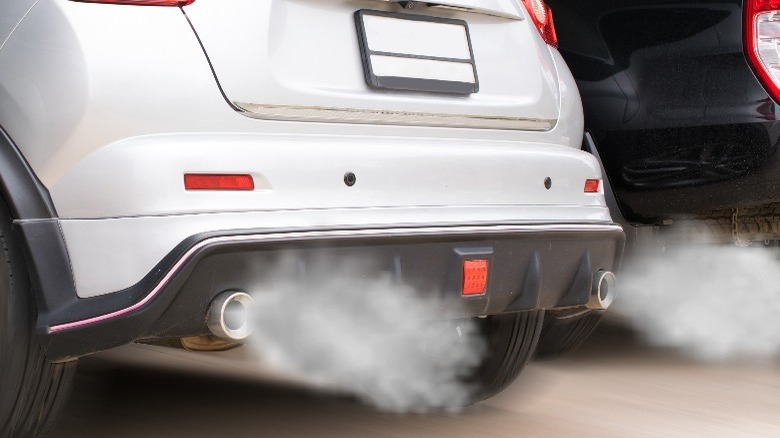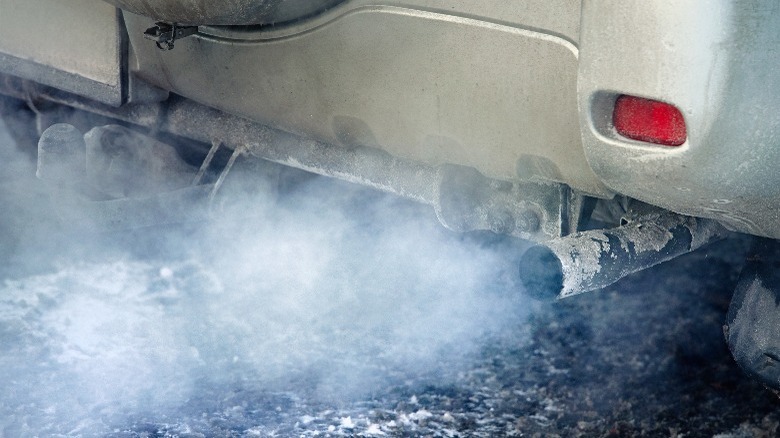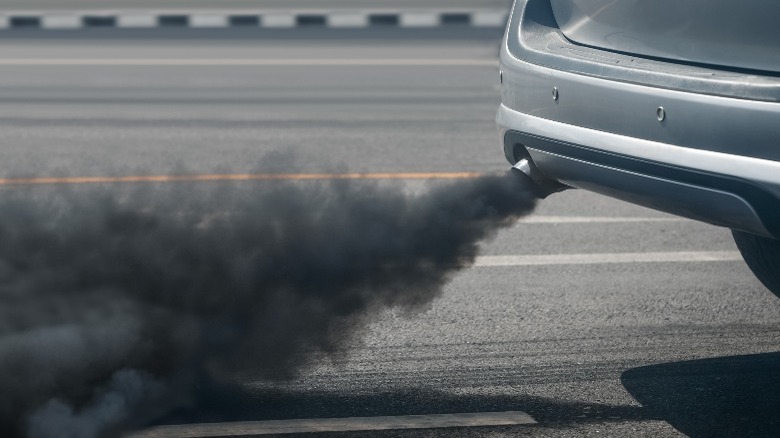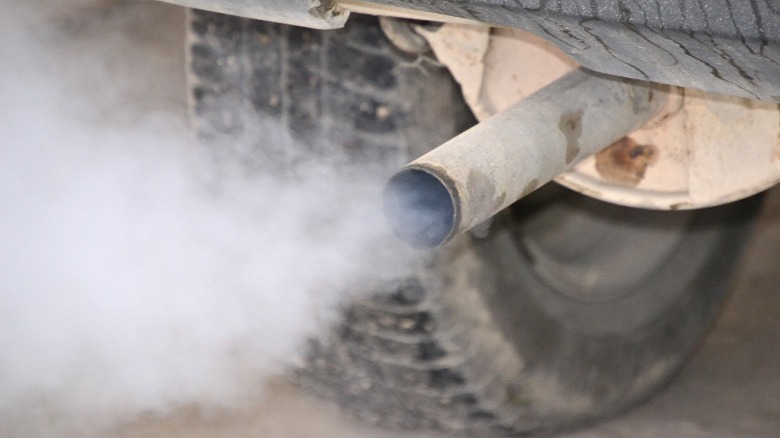Here's What Different Colors Of Exhaust Smoke Mean For Your Car
Similar to the human body, cars that aren't right will experience certain symptoms. These telltale signs can come as sounds you can hear or, in some cases, exhaust smoke you will see. Colorful exhaust smoke is an obvious example of something wrong with your engine. It is critical because, unlike other issues, exhaust smoke is linked directly to the car's engine.
The respiratory system is the closest thing in biology to which you can compare the exhaust. When an internal combustion engine "breathes," it sucks in air, which contains oxygen, combusts with fuel, creates power, and the leftover water vapor, carbon dioxide, and carbon monoxide are "exhaled" as exhaust out of the engine through the exhaust system.
Ideally, the exhaust fumes are supposed to be colorless, essentially invisible. However, environmental factors and engine malfunctions can bring forth colors. Luckily, you can use these visual cues to diagnose and ultimately fix your car. Every color means something (or several things), and you should be familiar with them so you know what to do when colorful smoke billows out of your tailpipe.
Little to no exhaust smoke color
If your car's exhaust smoke is completely colorless, it generally indicates that the combustion process in the engine is functioning efficiently and cleanly. The fuel is being burned completely, producing water vapor (H2O) and carbon dioxide (CO2) as the main byproducts. These gases are invisible under normal conditions, leading to a colorless appearance in the exhaust.
As a result, the absence of visible smoke or unusual colors in the exhaust indicates that the engine and its associated systems, such as the fuel and air intake, ignition, and exhaust systems, are in good working condition.
The colorless exhaust also means that your car is environmentally compliant. Vehicles designed to meet strict environmental standards aim for complete combustion to minimize the emission of harmful pollutants. A colorless exhaust is often a sign that the vehicle meets these standards, thanks to efficient engine operation and effective exhaust treatment systems like catalytic converters.
That's why most experts do not recommend catalytic converter deletes. The catalytic converter plays a crucial role in reducing harmful emissions from a car's exhaust, significantly contributing to the production of colorless exhaust smoke under normal operating conditions. The catalytic converter uses a catalyst to promote a chemical reaction that transforms harmful pollutants in the exhaust gas into less harmful substances.
White smoke
White exhaust smoke usually indicates more water (or water vapor) is present than usual. If not water, then some other water-based products, like coolant, may be in the combustion chamber.
You might wonder then about the white smoke you see on dewy mornings when you start your car. Does that indicate there's something wrong? Don't worry; a small amount of white smoke on startup is just condensation burning off, especially on colder days. This is normal and should dissipate quickly. If it persists, then you may be dealing with more than condensation.
If the smoke is thin, like vapor, and appears more prominently during startup, it might suggest a coolant leak into the combustion chamber. This happens when the head gasket is damaged or there's a crack in the engine block or cylinder head. As the coolant burns off, it produces white smoke. This is an internal coolant leak and one of the top reasons your car loses coolant and overheats.
You should shut down the car immediately to stop the combustion process. Check your coolant level and look for leaks. There will be hard-to-miss signs. Check your engine oil with the dipstick; if it appears milky or has a frothy quality, this could indicate that the coolant is mixing with the engine oil, a common consequence of a head gasket failure. The next step is to get the car inspected by a professional mechanic as soon as possible.
Blue smoke
Billowing blue smoke from a car typically indicates oil burning in the combustion chamber. Unlike white smoke, which is often related to coolant, blue smoke signals an issue with engine oil.
Engine oil is crucial for cooling and lubricating the engine. But in a system as intricate and complex as a combustion engine, a good thing in the wrong place can lead to bad consequences — or rather, too much of a good thing (even in the right place) could be bad.
It's normal for a small amount of engine oil to be in the combustion chamber. The oil there is by design and controlled carefully. It doesn't fill the combustion chamber but merely coats and lubricates specific components. However, blue smoke means there is more of it than there should be.
How? Apart from filling your car with too much oil, the most common cause of this issue is worn piston rings. Piston rings seal the gap between the pistons' outer edge and the cylinder walls' inner surface. They prevent oil from seeping up from the oil pan into the combustion chamber. Over time, these rings can wear out When this happens, their ability to seal effectively is compromised, allowing oil to pass through and burn with the fuel-air mixture. This is a common issue in older or high-mileage engines.
Another common reason is damaged or worn valve seals. They help control oil flow around the engine's valves. If they wear out, oil can leak into the combustion chamber and burn, producing blue smoke.
Black smoke
Black smoke from a car's exhaust typically indicates an overly rich fuel mixture — meaning there's too much fuel and not enough air being burned in the engine's combustion chambers. This condition can stem from various issues, leading to inefficient combustion and potentially decreased performance, increased fuel consumption, and higher emissions.
The car's engine and ECU constantly play a balancing game where they monitor and regulate how much air gets into the engine and add fuel to match it. The ideal air-fuel mixture ratio is 14.7 parts air to 1.0 parts fuel (14.7:1). The computer and the valves and components it controls try to ensure the fuel burns efficiently and optimally at the right ratio, ensuring good performance from the engine.
However, like any other system, things could fail, and black smoke is one sign that this balance is in question. Fuel is hydrocarbon-based, meaning it's composed of hydrogen and carbon. During complete combustion, carbon would typically combine with oxygen to create carbon dioxide (CO2), and hydrogen would combine with oxygen to form water (H2O). However, in a rich mixture, not all carbon finds oxygen to react with, leading to partially burned or unburned fuel. This unburned fuel contains carbon particles, which are expelled as black smoke.
Black and blue smoke are more common in diesel engines, and there's a dedicated article explaining why it occurs. You should check it out if it's relevant to you.
Gray smoke
Any of the colors listed above in less concentration may appear gray. Therefore, gray exhaust fumes could indicate a variety of problems. Unlike the straight signals from white, blue, or black smoke, gray smoke is the wildcard that could hint at a few issues under your car's hood. It's a bit of a puzzle because gray smoke might appear for various reasons that aren't as clear-cut.
Your car might be burning a little oil, but not in a way that is as obvious as with blue smoke. It could be a sign of a small oil leak or the beginning signs of wear in parts like the valve seals or piston rings. Your engine is letting oil get into places it shouldn't be, but only a bit at a time, which might make your exhaust look gray instead of blue.
Gray smoke can also flag issues with how your car mixes fuel and air. You may have faulty fuel injectors that do not let the air and fuel mix properly. However, it's not bad enough to pump out black smoke yet, but it's still not in good shape. Also, the kind of fuel you use or certain fuel additives can change the color of your exhaust smoke, too. So, figuring out gray smoke involves checking out many different things to nail down what's going on. It's best to take it somewhere for a proper diagnosis if you can't figure it out yourself.
